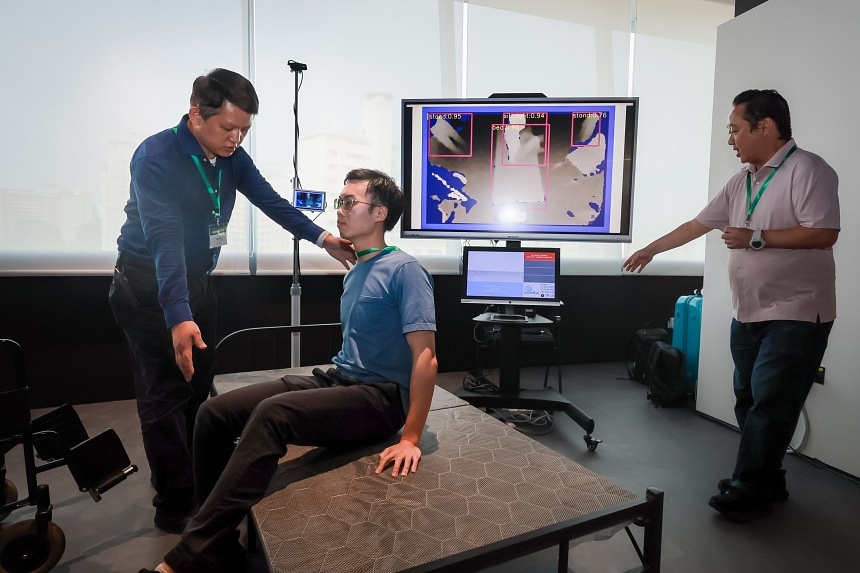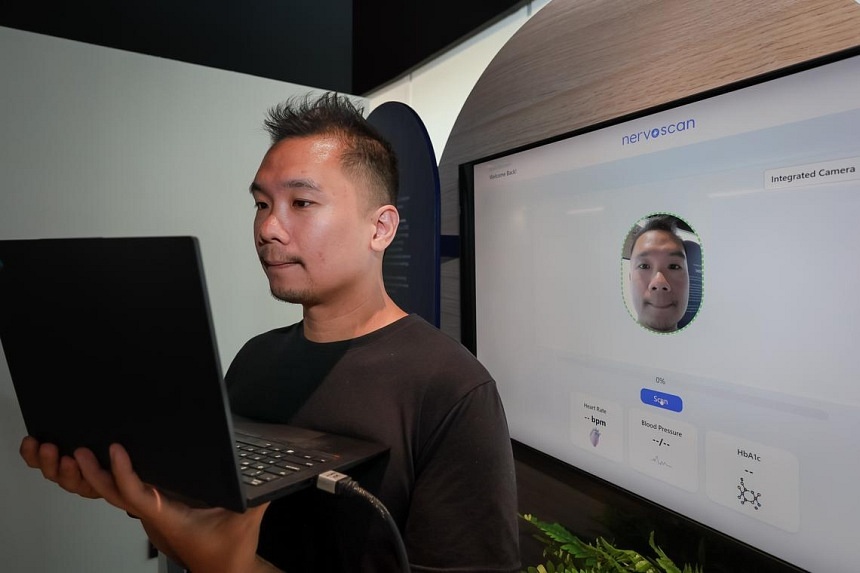from straitstimes.com:
A phone camera as health screening device? Healthtech agency’s new home displays innovations
A demonstration of a mobile fall detection system to monitor patients in both bed and wheelchair settings at a media preview at Synapxe’s Terrarium innovation lab. ST PHOTO: GAVIN FOO
Osmond Chia
UPDATED
SEP 19, 2024, 07:27 AM
FacebookTelegram
SINGAPORE – A new software that analyses users’ vital signs can turn any laptop or phone camera into a fully-fledged health screening device.
Developed by digital health start-up Nervotec, the contactless scanning technology used in the software can help users check their heart rate and blood pressure within seconds, improving telemedicine consultation services and speeding up mass screening exercises.
The scanning software was among the projects showcased at the launch of national healthtech agency Synapxe’s new innovation lab and office at the Elementum building in Buona Vista on Sept 18.
The agency was
rebranded from the Integrated Health Information Systems to Synapxe in 2023 to focus on digitalisation efforts in healthcare.
Addressing Synapxe employees and industry partners at the opening event, Health Minister Ong Ye Kung praised Synapxe for its progress in digitalising the sector, including its progressive roll-out of the next-generation electronic medical record system and its cyber-security initiatives.
He encouraged professionals to collaborate and identify use cases and ways to solve them to deliver better healthcare services.
The Terrarium innovation lab, which is around 2,000 sq ft in area, will regularly host pitching sessions, tech showcases and calls for innovation to address healthcare challenges as the nation faces manpower shortages and an ageing population.
Such events will help projects such as Nervotec’s scanning technology draw more interest, enabling new uses for them to be discovered.
Nervotec’s software can conduct screening without the need for invasive procedures, thus reducing costs. Under well-lit conditions, the software uses a standard smartphone or laptop camera to analyse a user’s vital signs, Nervotec founder Jonathan Lau said. For instance, the software tracks subtle changes in the colour saturation of a person’s face at 30 frames per second – the typical frame rate of most cameras – to determine the user’s blood pressure and heart rate.
The program also identifies fluctuations in the red, green and blue wavelengths picked up by the camera to determine a person’s haemoglobin and SpO2 levels. SpO2 refers to the amount of oxygen carried by red blood cells in the body.
Mr Lau declined to explain further how the software determines the haemoglobin and SpO2 levels as it is the software’s “secret sauce”, adding that the technology is still being peer-reviewed and will soon be trained on up to 1,000 patients’ scans to improve the accuracy of each reading.
Other prototypes on show at the Terrarium include local start-up SoundEye’s fall-detection system, which uses a laser sensor to look out for patients’ safety while they are in bed or on a wheelchair.
Nurses at the Singapore Christian Home have trialled at least five units of this device, which alerts them whenever it detects that a patient is at risk of falling over. In this way, fewer restraints are needed for residents with disabilities, improving their quality of life.
Nervotec founder Jonathan Lau demonstrating at a media preview on Sept 13 his company's camera-enabled facial features scanner to read a person's blood sugar level . ST PHOTO: GAVIN FOO
Unlike a closed-circuit television camera, the sensor captures only the body shapes of patients, without footage in colour that can be used to identify a patient.
Also on display were generative-AI tools, including Health Kaki, an app that provides users with personalised health goals and recommendations for recipes and food options, along with the estimated nutritional value, to stay on track.
Synapxe also developed a generative-AI platform for public healthcare professionals to test and deploy AI applications, such as chatbots and workflow management systems, in an enclosed network without the risk of data being leaked.
The agency’s office is also home to a new healthcare integrated operations centre, which monitors round the clock the health of IT infrastructure, applications and cyber-security operations used in the public healthcare sector.
Synapxe CEO Ngiam Siew Ying said at the lab’s opening: “(Before), our teams operated from different locations... Our new home allows us an opportunity to do things even better.
“With our monitoring, response and communications capabilities under one roof, we are able to detect issues earlier and resolve them faster.”

















































